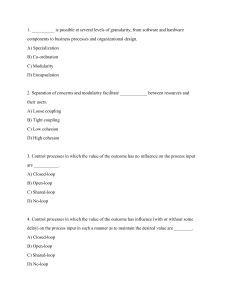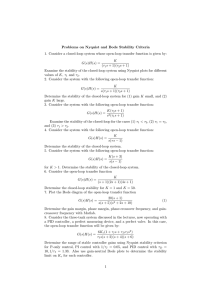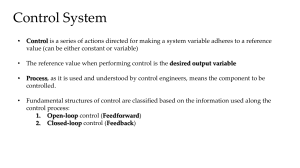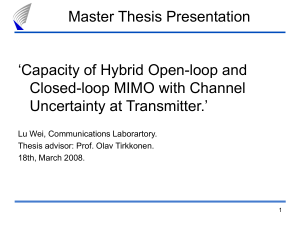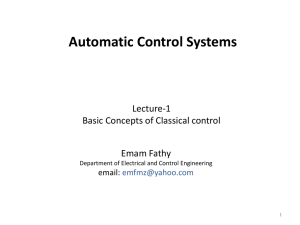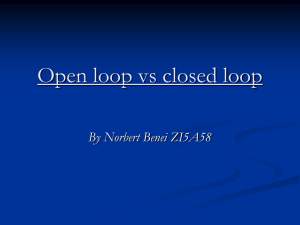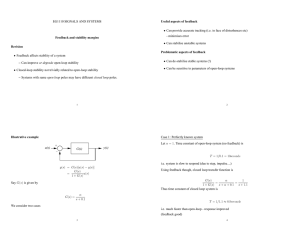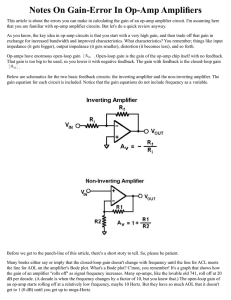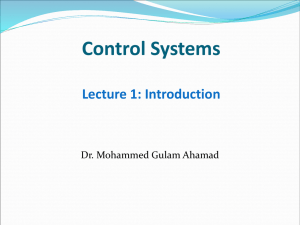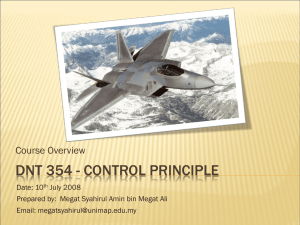CONTROL SYSTEMS: WHAT THEY ARE
advertisement
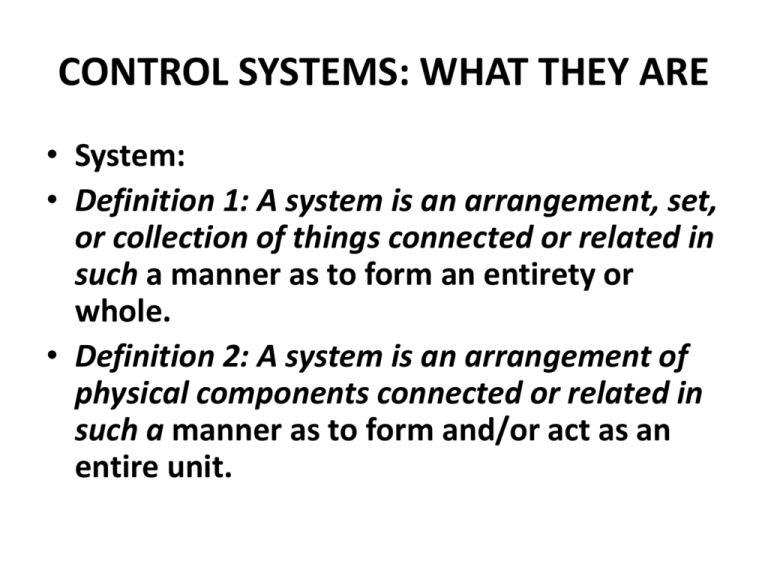
CONTROL SYSTEMS: WHAT THEY ARE • System: • Definition 1: A system is an arrangement, set, or collection of things connected or related in such a manner as to form an entirety or whole. • Definition 2: A system is an arrangement of physical components connected or related in such a manner as to form and/or act as an entire unit. • The word control is usually taken to mean regulate, direct, or command. Combining the above definitions, we have • Definition: A control system is an arrangement of physical components connected or related in such a manner as to command, direct, or regulate itself or another system. • before exemplifying this, we define two terms: • input and output, which help in identifying, delineating, or defining a control system. • Definition Input: The input is the stimulus, excitation or command applied to a control system, typically from an external energy source, usually in order to produce a specified response from the control system. • Definition Output: The output is the actual response obtained from a control system. • It may or may not be equal to the specified response implied by the input. The Inputs and outputs can have many different forms. Inputs, for example, may be physical variables, or more abstract quantities such as reference, set point, or desired values for the output of the control system. • The purpose of the control system usually identifies or defines the output and input. If the output and input are given, it is possible to identify, delineate, or define the nature of the system components. • Control systems may have more than one input or output. Often all inputs and outputs are welldefined by the system description. EXAMPLE1 • An electric switch is a manufactured control system, controlling the flow of electricity. By definition, the apparatus or person flipping the switch is not a part of this control system. Flipping the switch on or off may be considered as the input. That is, the input can be in one of two states, on or off. The output is the flow or non flow (two states) of electricity. The electric switch is one of the most rudimentary control systems. EXAMPLE2 • A thermostatically controlled heater or furnace automatically regulating the temperature of a room or enclosure is a control system. The input to this system is a reference temperature, usually specified by appropriately setting a thermostat. The output is the actual temperature of the room or enclosure. • When the thermostat detects that the output is less than the input, the furnace provides heat until the temperature of the enclosure becomes equal to the reference input. Then the furnace is automatically turned off. • When the temperature falls somewhat below the reference temperature, the furnace is turned on again. • A part of the human temperature control system is the perspiration system. When the temperature of the air exterior to the skin becomes too high the sweat glands secrete heavily, inducing cooling of the skin by evaporation. Secretions are reduced when the desired cooling effect is achieved, or when the air temperature falls sufficiently. • The input to this system may be “normal” or comfortable skin temperature, a “set point,” or the air temperature, a physical variable. The output is the actual skin temperature. OPEN-LOOP AND CLOSED-LOOP CONTROL SYSTEMS • An open-loop control system is one in which the control action is independent of the output. • A closed-loop control system is one in which the control action is somehow dependent on the output • Features of open-loop control systems are: 1. Their ability to perform accurately is determined by their calibration. To calibrate means to establish or reestablish the input-output relation to obtain a desired system accuracy. • 2. They are not usually troubled with problems of instability, a concept to be subsequently • . OPEN-LOOP AND CLOSED-LOOP CONTROL SYSTEMS • Closed-loop control systems are more commonly called feedback control systems, • Most automatic toasters are open-loop systems because they are controlled by a timer. The time required to make ‘‘good toast” must be estimated by the user, who is not part of the system. • An autopilot mechanism and the airplane it controls is a closed-loop (feedback) control system. Its purpose is to maintain a specified airplane heading, despite atmospheric changes. FEEDBACK • Feedback is that characteristic of closed-loop control systems which distinguishes them from open-loop systems. • Feedback is that property of a closed-loop system which permits the output (or some other controlled variable) to be compared with the input to the system (or an input to some other internally situated component or subsystem) so that the appropriate control action may be formed as some function of the output and input. • • • • CHARACTERISTICS OF FEEDBACK Increased accuracy Tendency toward oscillation or instability Reduced sensitivity of the ratio of output to input • Reduced effects of nonlinearities • Reduced effects of external disturbances or noise • Increased bandwidth. ANALOG AND DIGITAL CONTROL SYSTEMS • A signal dependent on a continuum of values of the independent variable t is called a continuous-time signal or, more generally, a continuous-data signal or (less frequently) an analog signal. • A signal defined at, or of interest at, only discrete (distinct) instants of the • independent variable t (upon which it depends) is called a discrete-time, a discrete data, • a sampled-data, or a digital signal. THE CONTROL SYSTEMS ENGINEERING PROBLEM • Control systems engineering consists of analysis and design of control systems configurations. • Analysis is the investigation of the properties of an existing system. The design problem is the choice and arrangement of system components to perform a specific task. • Two methods exist for design: • 1. Design by analysis • 2. Design by synthesis • Design by analysis is accomplished by modifying the characteristics of an existing or standard system configuration, and design by synthesis by defining the form of the system directly from its specifications. The choice and arrangement of system components to perform a specific task. CONTROL SYSTEM MODELS OR REPRESENTATIONS • Three basic representations (models) of components and systems are used extensively in the study of control systems: • 1. Mathematical models, in the form of differential equations, difference equations, and/or other mathematical relations, for example, Laplace- and z-transforms • 2. Block diagrams • 3. Signal flow graphs Identify the input and output for an automatic washing machine. • If the proper amounts of detergent, bleach, and water, and the appropriate temperature of the water are predetermined or specified by the machine manufacturer, or automatically entered by the machine itself, then the input is the time (in minutes) for the wash and spin cycle. The timer is usually set by a human operator. • The output of a washing machine is more difficult to identify. Let us define clean as the absence of • foreign substances from the items to be washed. Then we can identdify the output as the percentage of cleanliness. At the start of a cycle the output is less than 100%, and at the end of a cycle the output is ideally equal to 100% (clean clothes are not always obtained). Identify the organ-system components, and the input and output, and describe the operation of the biological control system consisting of a human being reaching for an object. The basic components of this intentionally oversimplified control system description are the brain, arm and hand, and eyes. • The brain sends the required nervous system signal to the arm and hand to reach for the object. This signal is amplified in the muscles of the arm and hand, which serve as power actuators for the system. The eyes are employed as a sensing device, continuously “feeding back” the position of the hand to the brain.Hand position is the output for the system. The input is object position.
